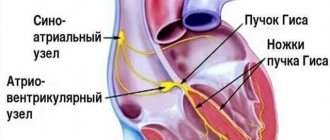© Author: A. Olesya Valerievna, candidate of medical sciences, practicing physician, teacher at a medical university, especially for SosudInfo.ru (about the authors)
The umbilical cord is a special organ through which the developing embryo, and subsequently the fetus, is connected with the mother’s body. Normally, the vessels of the umbilical cord are represented by two arteries and a vein , through which blood and the oxygen and nutrients contained in it are exchanged.
Until recently, it was possible to find out how the umbilical cord is built, how many vessels are in it and whether there are other anomalies only after the birth of the baby through visual examination and histological examination. With the introduction and widespread use of ultrasound techniques and Doppler measurements, it became possible to “look” inside the uterus even before birth, to trace the nature of blood flow and the anatomical features of this organ.
To assess the state of blood circulation in the mother-fetus system, determining the number of umbilical cord vessels and the characteristics of blood flow through them is of great importance. Normally, the doctor diagnoses the presence of three vessels, but in rare cases he may miss one, and then the expectant mother begins to worry seriously. Let's try to figure out why the lack of one of the arteries is dangerous, how it will affect the baby, and what a woman who has this anomaly should do.
Why can a single umbilical cord artery be identified in a fetus?
Possible reasons for identifying one umbilical cord artery:
- Sometimes a single umbilical cord artery is identified in completely normal fetuses . After the birth of a child, this fact does not have any impact on its further development.
- Sometimes a single umbilical cord artery is combined with defects of the fetal cardiovascular system , therefore, when a single umbilical cord artery is identified, a detailed examination of the anatomy of the fetus and, in particular, the cardiovascular system is carried out. In the absence of other malformations, a single umbilical cord artery is able to provide adequate blood flow to the fetus.
- Somewhat more often, a single umbilical cord artery is detected in fetuses with Down syndrome and other chromosomal diseases . However, this marker is a “minor” marker of Down syndrome, so identifying only a single umbilical cord artery does not increase the risk of Down syndrome and is not an indication for other diagnostic procedures.
- A single umbilical cord artery sometimes results in intrauterine growth restriction . In this regard, if a single umbilical cord artery is detected, an additional ultrasound is recommended at 28 weeks of pregnancy, and a planned one at 32-34 weeks. If a lag in the size of the fetus from the gestational age or disruption of blood flow in the vessels of the fetus and uterus is not detected, then the diagnosis of fetal growth retardation is excluded.
Formation and structure of the umbilical cord
The umbilical cord is a cord that connects the fetal surface of the placenta to the abdominal wall of the fetus. Its main components are blood vessels. On the outside, the umbilical cord is covered with a single layer of epithelial cells, and the vessels are surrounded by a jelly-like substance (Wharton's jelly), which plays a protective role, enveloping them on all sides.
By the end of pregnancy, the thickness of the umbilical cord reaches one and a half to two centimeters, the length is 50-70 cm, which allows the fetus to move freely in the uterine cavity even before birth, and the expectant mother feels peculiar tremors and movements. An excessively long or short umbilical cord is a sign of pathology.
As mentioned above, the umbilical cord must have two arteries and one vein. It is generally accepted that venous blood with carbon dioxide moves through the veins, and arterial blood rich in oxygen and nutritional components moves through the arteries. With the umbilical cord, the situation is somewhat different: the vein carries oxygenated blood to the tissues of the fetus, and the arteries carry venous blood away from the unborn baby.
The umbilical arteries exist only during fetal development. Departing from the internal iliacs, they pass along the inner surface of the abdominal wall, on the sides of the bladder in the form of a triangle, heading to the umbilical ring, where they are included in the umbilical cord. After birth, these vessels become empty, and only thin folds of peritoneum on the back of the abdominal wall remind of them.
There is only one umbilical vein, although initially there are two of them (the left one is reduced). Nature provides that only one vessel is sufficient to ensure adequate blood flow, so neither the fetus nor the mother experiences “inconvenience” due to an azygos vein. The umbilical vein delivers about 80% of the blood to the developing baby's inferior vena cava, and the remaining 20% is used for blood flow to the liver.
Uteroplacental blood flow system
The amount of blood that flows through the vessels of the umbilical cord during pregnancy is enormous. By the end of gestation, the fetus receives about 240 ml of arterial blood per minute through the vein, the same volume goes through the arteries to the placenta. About 5-20 minutes after the birth of a child, blood flow through the vessels of the umbilical cord remains, and at this time it can be taken for research and other purposes (preparation of medicines, for example), however, already during the birth process, under the influence of the release of the hormone oxytocin, the vessels of the umbilical cord begin to empty, and the organ quickly atrophies as unnecessary.
Video: series of lectures on fetal circulation
What to do if a single umbilical cord artery is identified in the fetus?
What to do if a single artery is visible on ultrasound:
- identifying only a single umbilical cord artery does not increase the risk of Down syndrome and is not an indication for genetic consultation or other diagnostic procedures.
- control ultrasound at 28 and 32 weeks of pregnancy to assess the rate of fetal growth and its functional state.
Dopplerography/Dopplerography during pregnancy
Dopplerography / Dopplerography, including color Doppler mapping, is a study of blood flow in the vessels of the fetus, the vessels of the umbilical cord and the uterus.
What does Doppler sonography show?
The results of Doppler sonography allow us to judge the state of the uteroplacental fetal blood flow and indirectly indicate the intrauterine state of the child.
Reliable information about the state of uterine blood flow can be obtained starting from 20–21 weeks. In late pregnancy (after 30 weeks), Doppler ultrasound is a desirable component of every ultrasound examination.
Normal blood flow indicators serve as a fairly reliable sign of the normal intrauterine state of the fetus, but do not exclude the development of certain complications in later stages of pregnancy.
The presence of blood flow disturbances in different parts of the utero-placental-fetal system requires strict dynamic control, including in a hospital setting.
Dopplerography is mandatory
- discrepancy between the size of the fetus and the gestational age
- abnormal amount of amniotic fluid
- premature ripening and other pathological conditions of the placenta
A Perinatal Consilium is held at the Center's branch.
Congenital malformations occupy a leading place among the causes of infant morbidity and mortality. The development of neonatal surgery has made it possible to significantly reduce perinatal losses in cases of surgically correctable fetal malformations, the detection of which is possible even in the prenatal period using echography.
Currently, it is not enough just to diagnose a developmental defect; it is also necessary to assess the prognosis of the child’s development after birth.
Our department has accumulated extensive experience in diagnosing congenital malformations, uses the most modern world methods for assessing postnatal (after birth) prognosis, and at the same time has introduced its own developments into practical activities.
DOPPLEROMETRY OF UROPLACENTAL, FETAL-PLACENTAL AND FETAL BLOOD FLOW
Doppler ultrasound is an ultrasound examination that can be used to detect disturbances in blood flow in the vessels.
Studies of utero-placental blood flow in the uterine arteries and fetal-placental blood flow in the umbilical cord artery have the greatest practical value during pregnancy; as well as fetal hemodynamics in the aorta and cerebral vessels of the fetus. Currently, an important diagnostic method is the study of venous blood flow in the fetus in the ductus venosus.
INDICATIONS FOR DOPPLER METRY DURING PREGNANCY
The main indications for Doppler study of blood flow in the “mother-placenta-fetus” system are extragenital diseases and complications of pregnancy: hypertension, hypotension, kidney disease, collagenosis, vascular diseases, diabetes mellitus, preeclampsia, fetal growth restriction or post-term pregnancy, oligohydramnios, polyhydramnios. , multiple pregnancy, resusensitization, etc.
Blood flow in the uterine artery
Blood flow in the umbilical cord artery
Blood flow in the fetal MCA
Information for specialists
Dynamics of Doppler studies in various obstetric situations
When assessing blood flow in the uterine arteries, the pulsatility index (PI>1.2) and the presence or absence of a dicrotic notch at the beginning of diastole are used. When assessing resistance in the uterine arteries, scoring criteria (UAS) are used. Select 4(UAS). UAS 0 – normal blood flow in both uterine arteries UAS 1 – presence of one pathological blood flow parameter (PI>1, 2 or the presence of a notch) UAS 2 – presence of two pathological blood flow parameters UAS 3 – presence of 3 pathological blood flow parameters UAS 4 – presence of pathological blood flow in both uterine arteries (PI>1, 2 and presence of notch)
When assessing blood flow in the umbilical cord arteries, the values of the pulsatility index and the presence or absence of diastolic blood flow are used. There are four types of blood flow (BFC) BFC 0 - normal blood flow in the umbilical cord arteries BFC 1 - PI greater than 2-3 standard deviations, diastolic blood flow is preserved. BFC 2 - PI greater than 3 standard deviations, diastolic blood flow is preserved BFC 3A - zero diastolic blood flow in the umbilical cord artery BFC 3B - reverse diastolic blood flow in the umbilical cord artery
Suspicion of intrauterine growth retardation
In the absence of abnormalities in the umbilical cord artery and BMD disorders: If the weight deviates from 22-27%: - type 0-2 - Doppler measurements once every 2 weeks; — type 3 – Doppler once a week; — type 4 – Doppler 2 times a week; Fetometry once every 2 weeks
In the absence of abnormalities in the umbilical cord artery and uterine arteries - deviation in weight from 28-34% - Doppler measurements 2 times a week; - weight deviation of 34% or more - Doppler measurements 2-3 times a week; Fetometry once every 2 weeks
In the presence of disturbances in the umbilical cord artery and the absence of disturbances in the uterine arteries - type 1 - Doppler and CTG 2 times a week; -type 2 - Doppler and CTG 3 times a week; -type 3A - resolve the issue of hospitalization and delivery. For a period of less than 34 weeks - Doppler measurements daily, CTG 2 times a day. - type 3B - emergency delivery, with a period of less than 26-27 weeks - decision of the council. Fetometry once every 2 weeks.
Clinical management of patients with a normal pregnancy and normal blood flow in the umbilical arteries, but with signs of increased resistance in the uterine arteries. UAS 0-1 - routine outpatient observation UAS 2 - outpatient observation, Doppler monitoring once a month UAS 3 - if dynamic ultrasound shows no changes in the dynamics of fetal growth - Doppler monitoring once a month; if the dynamics in weight changes from 9 to 10% - Doppler measurements and fetometry once every 2-3 weeks UAS -4 - Doppler measurements weekly, fetometry once every two weeks.
Federal State Healthcare Institution Clinical Hospital No. 81 FMBA of Russia 636000, Tomsk region, Seversk, st. Mira 4 Email:
ABSTRACT
: The velocity of blood flow in the umbilical vein was assessed in 112 women at different stages of pregnancy. The possibility of sufficiently high accuracy in calculating the volumetric blood flow velocity has been shown, which allows the use of this indicator along with angle-independent indicators in the diagnosis of placental dysfunction.
Currently, one of the priority areas of obstetrics is early diagnosis of the causes leading to the development of intrauterine diseases. This direction considers the fetus as a full-fledged patient of the fetal period, in which physiological and pathophysiological processes proceed according to their own laws inherent only to this time of life [1].
As is known, most often the general condition of the fetus begins to suffer due to fetoplacental insufficiency (FPI). The prevalence of this phenomenon is quite high, and one of the most pressing tasks of perinatal diagnostics and ultrasound angiology is the timely identification of hemodynamic disorders in the mother-placenta-fetus system with the subsequent development of rational pregnancy management tactics [2].
Today, Doppler methods for detecting FPN seem to be the most accurate, since it has been established that high peripheral vascular resistance is a reliable marker of hemodynamic disorders in both the uterine and umbilical arteries [3, 4].
At the same time, high impedance indices only in the umbilical cord arteries only indirectly indicate placental dysfunction, because these indicators indicate an obstacle to the outflow of blood from the fetus to the placenta, which does not always have hemodynamic significance for the embryo itself.
Thus, it seems quite reasonable and logical to study the functional state of the fetal-placental complex according to the volumetric parameters of the umbilical cord blood flow corresponding to the integral perfusion of the fetus.
To determine the dependence of the volumetric velocity of blood flow in the umbilical vein on the gestational age in women of the second half of uncomplicated pregnancy.
Material and methods
In the Perinatal Center of the Clinical Hospital No. 81 of the Federal Medical and Biological Agency of Russia, 112 apparently healthy women aged from 18 to 42 years (average 26 ± 5.5), randomly selected, were examined; the gestation period ranged from 22 to 39 weeks (average 30.3 ± 6).
The study did not include patients with gestosis, cardiovascular diseases, anemia, angiopathy and systemic vasculitis. In addition, pregnant women with intrauterine growth retardation of degree II or higher, embryogenesis defects, chronic intrauterine infections and placentation abnormalities were not included.
In accordance with the generally accepted protocol for antenatal care, all women underwent a comprehensive physical, laboratory and instrumental examination. At the first stage, a traditional diagnosis of the state of the hemodynamic system mother - placenta - fetus was carried out: a fundamental greyscale ultrasound examination (ultrasound) was carried out, as well as Doppler measurements of blood flow in the uterine and umbilical arteries, the aorta and the middle cerebral artery of the fetus [5].
The examination was completed by measuring and calculating the volumetric velocity of umbilical blood flow. On relatively straight sections of the umbilical cord, equidistant from the placenta and umbilical ring, located at a minimum angle to the direction of the ultrasound beams, the Doppler spectrum of the flow in the umbilical cord vein was recorded. The control volume was set so that its value corresponded to at least 2/3 of the vessel lumen, and the insonation angle was carefully adjusted. By enclosing the maximum possible spectrum, the time-averaged maximum blood flow velocity (TAV) was measured, the diameter of the vein was determined, and the volume of blood flow was calculated using the formula developed by specialists at the University of Washington School of Medicine [6]:
OSK
(ml/min
) =
0.6
×
π
×
¼D 2 (cm 2)
×
TAV (cm/s)
×
60 (s)
All diagnostic procedures were carried out in the first half of the day by one expert using an Aloka 5500 ProSound device using a convex sensor 3.5 MHz. To increase the accuracy of planimetric measurements, a double magnification mode (Zoom) was used; to reduce the temperature effect on the fetus, color Doppler mapping was used with minimal exposure.
The BSC measurement was performed at least three times with the calculation of the arithmetic mean value, which was recognized as the final parameter under study.
Statistical data were presented indicating the minimum and maximum values in the samples, general means and double standard deviations (M±2SD). The distribution of variables was estimated using the D'Agostino-Pearson method.
The correspondence of the volumetric velocity of umbilical blood flow to the gestational age was determined in the process of conducting correlation and regression analysis with calculation of the regression equation.
In each case, the level of statistical significance p was determined, the “null hypotheses” were rejected when p 2 was 0.8, analysis of variance demonstrated an F-test level of 442 (p Up
It is impossible to imagine an area of medicine where additional examination methods would not be used. Ultrasound, due to its safety and informativeness, is especially actively used in many diseases. Doppler measurements are an opportunity not only to assess the size and structure of organs, but also to record the features of moving objects, in particular, blood flow.
Ultrasound examination in obstetrics provides a huge amount of information regarding the development of the fetus; with its help, it has become possible to determine not only the number of embryos, their gender and structural features, but also to observe the nature of blood circulation in the placenta, fetal vessels and heart.
The procedure for the patient feels no different from a standard ultrasound. To prepare for a Doppler examination of a pregnant woman, you do not need to do anything, however, it is advisable not to eat food a couple of hours before visiting the ultrasound room, but to limit yourself to water. A special conductive gel is applied to the surface of the pregnant woman’s abdomen, which helps the penetration of the ultrasound signal, and an ultrasonic sensor is installed, which is smoothly moved along the surface of the abdomen.
The method allows you to determine the diameter and location of the main arteries not only of the fetus, but also of the placenta, umbilical cord, uterus, and the speed of blood flow through the vessels. Doppler ultrasound also helps to identify dysfunctions of the placenta, which can lead to complications during pregnancy and during childbirth.
If your doctor has prescribed you an ultrasound with Doppler, then all types of ultrasound can be done with us:
- ultrasound of the veins of the lower or upper extremities
- ultrasound of the arteries of the neck and head
- Ultrasound of the bracheocephalic arteries
- ultrasound of the uterine arteries
- ultrasound of pelvic veins
- ultrasound of umbilical cord vessels (USV)
- Ultrasound of the veins of the pampiniform plexus
- ultrasound of coronary veins, ultrasound of scrotal veins
- Dopplerometry of heart vessels in adults and children
as well as Doppler measurements of other vessels.
Consult our specialist by phone: +7 (4822) 31-30-31
Doppler standards by week
For each stage of pregnancy, certain normative values of blood flow indices correspond. If the obtained values correspond to them, then the blood flow is normal.
Do not despair if the study reveals some deviations. The results obtained will allow the doctor to correct the further course of pregnancy and prevent possible problems.
The norms for Doppler measurements during pregnancy are presented in the table:
After 18 weeks of pregnancy, with sufficient grounds, the doctor prescribes an additional examination to the patient in addition to the already planned ultrasound diagnosis. Dopplerography of the uteroplacental blood flow reveals disturbances in the “mother-placenta-fetus” system and makes it possible to prevent their development in time.
Where is the norm and where is the pathology?
Around the 21st week of gestation, all pregnant women are sent for a Doppler study, which allows one to evaluate not only the anatomical features of the fetus, placenta, and umbilical cord, but also the characteristics of blood flow (speed, number of vessels, anomalies). Often doctors do not bother to explain the results of the analysis to the patient, even briefly, so expectant mothers scour the literature and the Internet in search of answers.
Normally, at any stage of pregnancy, the umbilical cord has 3 vessels. Having received such a conclusion, the woman can calm down - the blood flow is fine (of course, if no other anomalies are found). In some cases, the ultrasound diagnostic doctor does not detect one artery in the umbilical cord, then the conclusion will indicate that there are only two vessels - one vein and one artery.
If there is an insufficient number of umbilical cord vessels, specialists will have to figure out whether the anomaly is isolated or combined with other defects, which is often found in this type of pathology. Some women note that the number of vessels during ultrasound differs at different times, and this creates even more questions, misunderstanding and unnecessary anxiety for the expectant mother.
Note that the number of vessels should not change throughout pregnancy, so there are two conclusions: either one of the arteries stopped functioning for some reason, or an error was made in one of the studies, and it is necessary to “recount” the vessels again, preferably – from a competent and experienced doctor who will dispel all doubts.
The essence of the Dopplerography method of uteroplacental blood flow
The newly formed fetal blood supply system supplies nutrition not only to the unborn baby, but also to the placenta - the protective membrane. Not only the physical protection of the fetus depends on the completeness and timeliness of blood supply. Good blood supply affects:
- the ability of the placenta to prevent the penetration of toxins;
- the baby's development in the following weeks;
- the ability of the mother's body to neutralize toxins.
Doppler ultrasound (DPM) is a study using a conventional ultrasound machine. The essence of the technique is to use the Doppler effect: when reflected from moving objects (red blood cells), ultrasound waves change their frequency. The device records the received data and displays an image of the blood flow on the screen. An experienced doctor, based on research, determines whether there are deviations in the functioning of the blood supply system, and how dangerous they are.
What is an umbilical cord, why is it needed?
The umbilical cord (also called the umbilical cord) is a rope-like organ of a grayish hue that acts as a connecting link between the fetal surface of the placenta and the abdominal wall of the embryo, and subsequently the fetus.
With the help of this formation, blood, oxygen and necessary nutrients are supplied to the tissues and organs of the developing child. The umbilical cord has a smooth, shiny, elastic surface with a consistency similar to rubber. By the end of the gestational period, its thickness is 1.5-2 cm. The length of this organ reaches up to 70 cm, which allows the baby to move freely in the uterine cavity. An umbilical cord that is too long and short (less than 50 cm) are manifestations of pathology.
Indications and contraindications for diagnostics
The basis for Dopplerography of uteroplacental blood flow are several groups of factors:
- Diseases of a pregnant woman: diabetes mellitus, hypertension, collagen vascular diseases, preeclampsia (increased blood pressure after 20 weeks), kidney disease, Rh sensitization (Rh difference between spouses).
- Diseases and malformations of the fetus: growth retardation, causeless oligohydramnios or dropsy, premature ripening of the placenta, discrepancy between fetal weight and gestational age, heart defects, etc.
- Other reasons: abdominal injuries, age more than 35 or less than 20 years, pathological type of cardiotocogram, postmaturity, unsuccessful previous pregnancies, entanglement of the fetal neck with the umbilical cord.
The doctor has the right to prescribe DPM for any condition of the pregnant woman or fetus that causes fear for the life of the unborn child. The study is used to assess the effectiveness of treatment for uteroplacental insufficiency and the threat of late miscarriage.
Features of Doppler testing
The examination procedure is absolutely safe and is almost no different from a regular ultrasound:
- The patient lies on the couch on her back and exposes the abdominal area.
- The doctor applies a special gel to the pregnant woman’s skin to improve image quality.
- The specialist first examines the general condition of the uterus and fetus for possible abnormalities.
- After this, the doctor turns on the Doppler function and examines the condition of the area of \u200b\u200bthe circulatory system of interest: the aorta, cerebral arteries, etc.
- The results are automatically entered into a special section of the program and analyzed.
If there are deviations, this is immediately visible on the screen. The duration of the procedure is from several minutes to half an hour. The time depends on the volume of the area requiring inspection and the level of qualification of the specialist.
There are no contraindications to the procedure - this is a safe ultrasound examination method, which has been confirmed by many years of clinical trials.
Consequences of violations identified during the inspection
Timely diagnosis detects the emergence and development of pathological conditions at the earliest stages. The accuracy of examinations largely depends on the doctor’s experience and the availability of modern equipment.
When referring for Dopplerography of uteroplacental blood flow, the procedure must be completed without fail. Otherwise, negative consequences are possible:
- abnormalities in child development;
- fetal death;
- increased likelihood of miscarriage;
- low birth weight of the child;
- hormonal imbalance;
- pathologies of the heart and blood vessels.
The good health of the unborn child is the most important incentive for a happy life for most people. Correct implementation of DPM can detect the presence of developmental disorders in the early stages - and respond in a timely manner.
The Harmony clinic has everything you need to carry out Doppler measurements: qualified doctors, modern equipment, affordable prices and first-class service. If you want the procedure to be guaranteed to be not only accurate, but also safe for the baby, then come to us!
| Code | Name of service | Price |
| 0408 | Dopplerography of uteroplacental blood flow | 1200 rub. |
Note
LLC "Harmony" provides discounts of 10%:
- Veterans
- For pensioners
- For disabled people
- Large families
- Medical workers
With Doppler ultrasound, it is possible to obtain CSC from the superior and inferior vena cava, ductus venosus
, hepatic veins, pulmonary veins, and also umbilical veins. The most studied vessels are the inferior vena cava (IVC) and the ductus venosus (DV). The curve of blood flow velocity from the inferior vena cava, obtained by studying its segment located immediately distal to the junction with the ductus venosus, is characterized by a three-phase profile.
The first antegrade wave corresponds to ventricular systole
(SG), the second antegrade wave of a smaller size - early ventricular diastole, and the third, characterized by the reverse direction of blood flow, corresponds to the phase of atrial systole (AS). Various indices have been proposed for the analysis of FCS in the IVC, but our recent studies have demonstrated that the assessment of the preload index is more effective than others described in the literature for predicting the threatening condition of the fetus.
This index, expressing the relationship between the maximum speed
venous blood flow in the phase of atrial systole and its maximum speed in the phase of ventricular systole (Preload Index (A/S) = SP /SF), depends on the pressure gradient between the right atrium and the right ventricle at the end of diastole, which is a reflection of both the diastolic function of the ventricles, and the level of end-diastolic pressure in them.
Visualization of the venous duct is possible
with a cross section of the upper abdomen of the fetus at the level of its origin from the umbilical vein. Then the Color Doppler mode is turned on, and the control volume of the pulsed wave Doppler is set slightly above the area of entry of the ductus venosus (closer to the umbilical cord vein) - at the point where the maximum blood flow velocity is recorded during Color Doppler. Its CSCs are characterized by a biphasic nature, with the first peak corresponding to ventricular systole (wave S), the second to ventricular diastole (wave D), and the lowest blood flow velocity is observed during atrial systole (incisura A).
Among the proposed indices
To quantitatively characterize the SSC in the venous duct, the angle-independent S/A ratio between the maximum velocities in ventricular systole (S) and atrial systole (A) turned out to most effectively reflect its hemodynamics.
The type of SSC of the hepatic veins is similar
the same in the NPV. There are a few studies in the literature devoted to the study of blood flow in these vessels in the fetus, however, given the data presented in them, it can be argued that analysis of blood flow in the hepatic veins can be as informative as in the IVC.
KSK of pulmonary veins
examined in the area of their entry into the right atrium. The appearance of the resulting curves will also be characterized by antegrade blood flow during the phase of atrial contraction. Identification of marked changes in the nature of blood flow in the IVC and pulmonary veins is of particular interest, since this may reflect the state of hemodynamics in the systemic and pulmonary venous circulation during intrauterine development of the fetus.
blood flow
in the umbilical cord vein is usually continuous.
However, if there is reverse blood flow in the IVC during the phase of atrial contraction in the umbilical cord vein, a pulsating nature of the CSC may be observed. During the normal development of pregnancy, this kind of pulsation is observed only up to 12 weeks and is a reflection of the rigidity of the ventricular walls in this gestational period, which determines the high frequency of reverse blood flow in the IVC. In later stages of pregnancy,
recording the pulsatile nature of blood flow in the umbilical cord vein will be a sign of severe cardiac dysfunction.
— Return to the table of contents of the section “Obstetrics.”
DOPPLER METRY is a type of ultrasound examination that is used to diagnose blood flow in vessels, for example, in the area of the umbilical cord or uterus.
Based on the indicators, problems during pregnancy, abnormalities and pathologies associated with fetal development or the condition of internal organs are identified.
The study determines the size of the vessels, the speed of blood flow and indicates places with existing disorders in the uterus, umbilical cord and fetal body.
Doppler testing during pregnancy is necessary to determine treatment strategies for diseases associated with the circulatory system.
The study is divided into 2 types:
- duplex - provides materials for calculating the speed of blood movement through the vessels;
- triplex - additionally determines the direction of movement and provides complete information about blood flow.
Preparation for the procedure
Before the test, it is not recommended to take food or liquid for 2 hours. Doppler testing is painless and does not require special preparation.
Indications for Doppler testing
The study is carried out as prescribed by a doctor during the third trimester and is classified as planned. The gynecologist prescribes Doppler ultrasound at 30-34 weeks of pregnancy, when the fetus is formed and abnormalities are clearly visible.
Indications for the study:
- Kidney disease, hypertension, diabetes or gestosis in a woman
- Deviations in fetal development - pathologies of internal organs, disturbances in the condition of the placenta.
- Slow embryonic growth.
- Previous abortions and miscarriages.
- The age of the woman is under 20 and after 35 years.
- Suffered serious injuries and operations.
Diagnosis of the umbilical cord condition
The most reliable information about the condition of the umbilical cord and its vessels can be obtained by ultrasound examination with color Doppler mapping. A transverse “section” of the umbilical cord shows the presence of a larger vessel – a vein, and a smaller diameter – an artery. The number of vessels is assessed from the longitudinal image. Data on the number of vessels can be obtained by the end of the first trimester, at about 12 weeks, when the woman is sent for the first screening test.
The accuracy of diagnosing the number of umbilical cord vessels can be influenced by various factors: the impossibility of good visualization of the organ too early or on the eve of birth, a small amount of amniotic fluid, more than one fetus in the uterus, excess weight in a pregnant woman. The qualifications of the doctor conducting the study also play a significant role.









